

|
Astronomy 161:
An Introduction to Solar System Astronomy
Prof. Richard Pogge, MTWThF 2:30
|
Lecture 20: Tides
Key Ideas
Tides are caused by differences in the gravitational pulls of the Moon
and Sun between near and far sides of the Earth.
- Earth's Tidal Bulge
- Spring & Neap Tides
Tidal Effects in the Earth-Moon System:
- Tidal Locking of the Moon
- Tidal Braking slowing the Earth's Rotation
- Lunar Recession (increasing size of the Moon's orbit)
Seashore Astronomy
Ocean Tides are a familiar phenomenon to those who make their homes
near the sea:
- Sea level is highest twice a day at "high tide"
- Sea level is lowest twice a day at "low tide"
People near the sea quickly notice that the timing of the tides
was governed by the motions of the Moon:
- The time between successive high tides is 12h 25m
- The time between successive moonrises is 24h 50m, or
twice the time between high tides
This folk intuition is correct: Tides are in fact caused primarily
by the gravitational pull of the Moon.
Differential Gravity
The gravitational force exerted by the Moon on the near and far sides of
the Earth is different:
- The Moon is 12740 km closer to the near side of the Earth than the
far side
- This results in a 7% stronger gravitational force on the near side
compared to the far side
This causes a net front-to-back differential gravitational force felt by
the Earth:
- Stretches the Earth along the Moon-Earth line
- Squeezes the Earth at right angles to this line
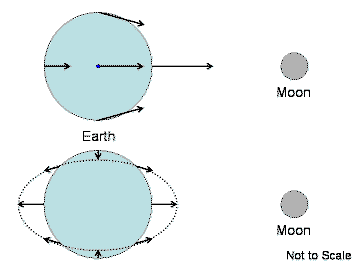
[Click on the image to view full size (6.1k GIF)]
The net result is 2 tidal bulges on opposite sides of the Earth, and so
2 tides per day as the Earth rotates through the Earth-Moon line.
Land and Sea Tides
How big is the Tidal Bulge of the Earth?
The main body of the Earth is made of rock, which is stiff and
resists deformation by tides.
- "Body Tides" on Earth are only about 30 centimeters high.
The oceans are made of water which is fluid and flows easily
in response to the tidal forces:
- Ocean Tides on Earth are about 1 meter high in the open sea
- Near the shore, tidal flows and the seafloor shape can
work together to produce much larger local tide
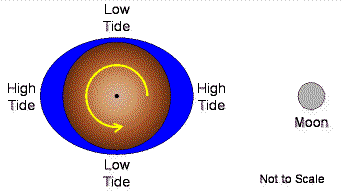
[Click on the image to view full size (16k GIF)]
Some of the most extreme ocean tides on Earth are observed in Canada's
Bay of Fundy between Nova Scotia
and New Brunswick. Here the shape of the bay leads to average high tides of
12 meters compared to low tide, with maximum high tides of up to 17 to
18 meters!
Sun Tides
Gravity is a universal force, so tides are raised between any two bodies.
The Sun also raises tides on the Earth:
- The difference between the gravity force on the day and night sides
of the Earth are about half that due to the Moon.
The Sun and Moon work together to give different kinds of tides and
different times of a Lunar Month.
Spring Tides:
- The highest High Tides
- Occur during New Moon and Full Moon, when the Moon and Sun
are lined up with the Earth.
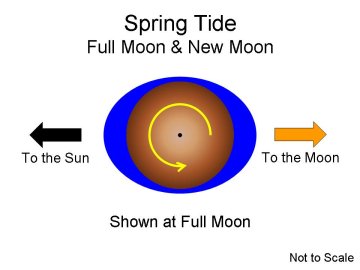
Neap Tides:
- The lowest High Tides
- Occur at First Quarter and Last Quarter phase,
when the Moon and Sun are at right angles seen from Earth.
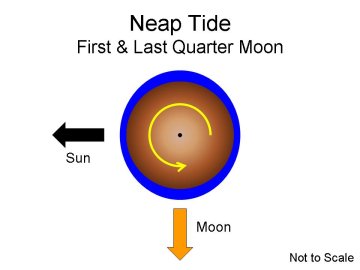
Tidal Locking of the Moon
Similarly, the Earth raises tides on the Moon
- The Earth is more massive, and the Moon's radius is smaller.
- Earth tides are ~20x stronger than Moon tides.
The early Moon rotated much faster:
- This means it was rotating through its tidal bulge.
- This generated tremendous internal friction, slowing
the Moon's rotation.
- Eventually, the Moon's rotation slowed until it matched
its orbital period, and the friction stopped.
The end result is that the Moon got Tidally Locked in
Synchronous Rotation.
This is why the Moon always keeps the same face towards the Earth,
as we saw back in Lecture 8.
Because the rotation and orbit periods are the same, we say that the
Moon is locked in a 1:1 Tidal Resonance with the Earth.
Tidal Braking of the Earth
The Earth rotates faster than the Moon orbits the Earth (24 hours compared
to 27 days).
There is therefore friction between the ocean and the seabed as the Earth
turns out from underneath the ocean tidal bulges.
- This drags the ocean bulge in the eastward direction of the Earth's
rotation.
- Result is that ocean tides lead the Moon by about 10-degrees
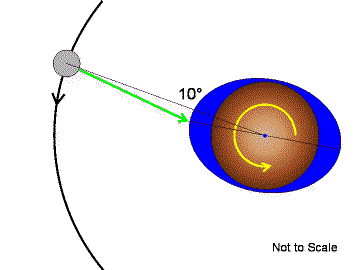
[Click on the image to view full size (18k GIF)]
The friction from the ocean tides robs the Earth of rotational energy,
acting like brake pads.
This effect is known as Tidal Braking
- Slows the Earth's rotation a tiny amount.
- The length of the day is getting gradually longer by
about 2.3 milliseconds per century at the present time.
[20.1]
Another effect of the Tidal Braking is that the extra mass in the ocean
bulges leading the Moon causes a small net forward tug.
- Results in a net forward acceleration of the Moon
- Moves the Moon into a slightly larger orbit
This effect is known as Lunar Recession
- Steady increase in the average Earth-Moon distance by about 3.8 cm
per year.
The Lunar Recession rate is measurable using Laser Ranging experiments
that use retroreflector arrays left on the Moon by the Apollo missions
(Apollo 11, 14, and 15), and two Soviet landers (Lunakhod 1 and 2).
Telescopes on Earth bounce laser beams off the reflector arrays and measure
the distance to the Moon to millimeter precision.
[20.2]
The Once and Future Moon
Lunar Recession and Tidal Braking of the Earth's rotation are coupled: the
rotational energy being taken from the Earth in braking is effectively
being transferred, via tides, to the Moon. This extra energy lifts it
into a higher orbit.
As a result:
- The length of the day has gotten longer at a rate of about 1.7 milliseconds
per century [see Note 20.3] averaged over
the past 2700 years.
- The Moon recedes by about 3.84 meters/century on average.
After many Billions of years, this will add up until:
- The Moon will be ~50% farther away from the Earth
- The Lunar Sidereal Month will be about 47 days long
- The Earth's rotation period (the day) will be 47 days long
The Earth & Moon would then be locked together in a 1:1
Tidal Resonance, and always keep the same face towards each other.
Once the Earth and Moon are tidally locked, further tidal evolution
should stop. However, remember that the Earth and Moon orbit the Sun,
and so tidal effects from the Sun will come into play, and continue to
evolve the Earth-Moon system dynamically. The details are quite
complicated, and beyond the scope of this course (and, to be fair, even
the experts argue among themselves about the details - it is a difficult
problem!).
[20.4]
Dynamical Evolution
Tidal phenomena are extremely important throughout the Solar System.
In the remainder of the class, we will often encounter examples of tides
playing a role in the dynamics of planets and their moons.
Some examples:
- Tidal Resonances determining rotation periods (Moon & Mercury)
- Tidal Locking (Pluto & Charon system)
- Tidally-induced Heating (Io around Jupiter, and Triton around Neptune)
Tides are essential to understanding the dynamical evolution of the
Solar System.
Return to [
Unit 4 Index
|
Astronomy 161 Main Page
]
Updated: 2007 October 14
Copyright © Richard W. Pogge,
All Rights Reserved.




